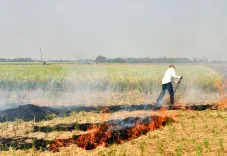What is the current death toll from Crimean-Congo hemorrhagic fever in Iraq?

Synopsis
Key Takeaways
- Death toll from CCHF in Iraq has reached 30.
- 231 cases reported nationwide this year.
- Highest infections in Dhi Qar province.
- Precautions include buying meat from health-approved sources.
- CCHF has a high fatality rate of 10% to 40%.
Baghdad, July 21 (NationPress) The number of fatalities due to Crimean-Congo hemorrhagic fever (CCHF) in Iraq has now reached 30, with a total of 231 confirmed cases reported across the nation since the start of this year, as disclosed by the Iraqi Health Ministry on Monday.
According to ministry spokesperson Saif al-Badr, the southern province of Dhi Qar has seen the highest incidence of infections, tallying 84 cases and four deaths, with Baghdad following closely with 38 cases and six fatalities.
This recent statistic reflects a rise from the earlier numbers released by Iraqi health officials on June 12, which reported 123 cases and 19 deaths, as reported by the Xinhua news agency.
Al-Badr advised the public to acquire meat only from health-approved slaughterhouses, ensure it is stored at extremely low freezing temperatures, and cooked thoroughly to eradicate pathogens.
CCHF, which manifests through symptoms like fever, muscle pain, headaches, and bleeding, carries a high mortality rate ranging from 10% to 40%.
Since the late 1970s, CCHF has been recognized as the most prevalent viral hemorrhagic fever in Iraq, with its largest outbreak occurring in 2023, resulting in over 587 cases and 83 deaths, primarily impacting southern regions.
The World Health Organization (WHO) describes CCHF as a widely distributed disease instigated by a tick-borne virus (Nairovirus) from the Bunyaviridae family, causing severe viral hemorrhagic fever outbreaks with a case fatality rate of 10–40%.
This virus can be transmitted to humans through tick bites or contact with infected animal blood or tissues during the slaughtering process. The majority of cases have been reported among individuals working in the livestock sector, including agricultural workers, slaughterhouse personnel, and veterinarians.
Additionally, human-to-human transmission can occur through close contact with the bodily fluids of infected individuals. WHO emphasizes that hospital-acquired infections may result from inadequate sterilization of medical tools, reuse of needles, and contamination of medical supplies.









